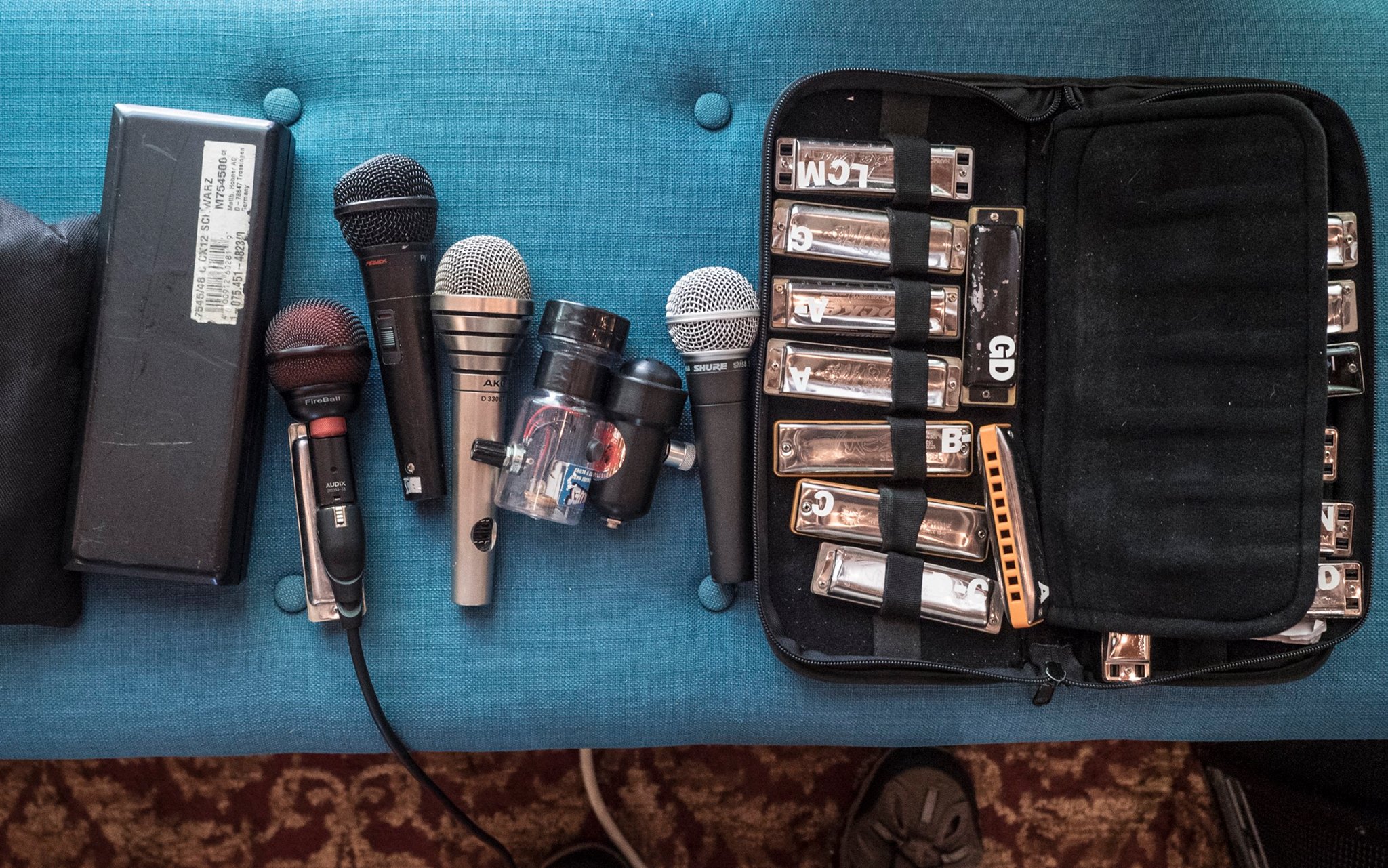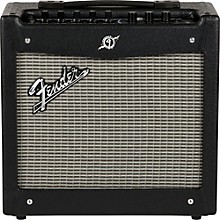
Loud, proud, and inexpensive–What’s not to like?
I get a lot of questions from beginners about what gear they should buy to get started making amplified music with harmonica. In this piece I’ll make a couple of simple recommendations for gear that does a few things well:
- It sounds good. Not just sorta good. Good.
- It’s inexpensive and durable.
- It will be useful long after the beginner has graduated from novice status.
The basics
There are two or three basic pieces that make up a minimally featured amplified rig:
- The amp. This is what makes the sound loud. It can also change the nature of the sound.
- The microphone. The mic is what translates the sound of the harp into a signal that the amp can big up.
- A delay or reverb unit. Not absolutely essential, but a harmonica sound without one or the other of these can get boring pretty quick.
Mic and Amp
An important thing to remember about mics is that different mics work better, or worse, with a given amp. Therefore, it’s a good idea to choose the mic and amp together.
A standard blues harp configuration is a bullet-style mic (Shure Green Bullet or Astatic JT-30) coupled with a small (5 watt) tube amp.Â
A good choice for the amp is the Epiphone Valve Junior. With the “half stack” speaker option, this rig runs about $250, and the mic will add about $125. 5 watts is surprisingly loud, and you’ll definitely get a feel for amplified playing with this setup.
Get one of the newer Valve Juniors as opposed to an older used one–the old ones have a problem with loud hum.  This setup is good for amplified blues, but not much else.  In particular, bullet-type mics don’t sound good at all coming through a PA system, so if you don’t have your amp at a jam session, you’re out of luck.
A different rig that’s more flexible and less expensive is a Vox DA-5 modeling amp ($129) plus an Audix Fireball V mic ($125). The amp is a 5-watt setup based on chip-driven amp “modeling” technology.  In addition to a range of amp sounds, it includes decent built-in reverb, delay, chorus, flange, and tremolo, and it has a line-out that lets you run the output from the amp straight to a PA system. Not bad. The Fireball V mic can be used with lots of amped setups, and it also sounds very good coming right through the PA.
There are dozens of choices for amps and mics out there. These are two setups that work well and will keep working well. You might also want to try one of the industry workhorse Shure mics, like the SM57 or SM58, both of which are quality gear, very useful for vocals, and priced around $100. Their sound has more “edge” (treble content) than the Fireball, and they tend to feedback a bit more when used with harp. Try before you buy!
Click on an image or a title to check out the gear at
…we get a lot of our gear there… good prices, good service and a 45-day return policy…

Epiphone Valve Junior Half Stack

Vox DA5 5W 1×6.5 Guitar Combo Amp Black

Audix FireBall-V Harmonica Microphone

Shure 520DX Green Bullet Mic

Shure SM57 Instrument/Vocal Mic
If you get any of these mics except the Bullet, you’ll need an XLR mic cable plus an inline lo-z to hi-z transformer (to change the low-impedance mic signal to a high-impedance signal that the amp can work with). Budget $40-50 for those too…
Related Posts
6 Comments
Leave a Reply
You must be logged in to post a comment.
WHAT’S NEW
Categories
- Audio/Video
- Blog
- Blue Future
- Digitech RP Tricks and Tips
- Discography, CDs, Projects, Info, Notes
- Featured Video
- For the Beginner
- Gallery
- Hunter's Effects
- Hunter's Music
- Huntersounds for Fender Mustang
- Meet the Pros
- More Video
- MPH: Maw/Preston/Hunter
- My Three Big Contributions
- Player's Resources
- Pro Tips & Techniques
- Recommended Artists & Recordings
- Recommended Gear
- Recorded Performances
- Reviews, Interviews, Testimonials
- The Lucky One
- Uncategorized
- Upcoming Performances
- Zoom G3 Tips and Tricks


Hi Richard
Please tell me what a digitech rp is. I play diatonic harps, What does the rp do ?
Sorry if this seems so simple, but I really need a primer on the basics of this.
Thanks
Wayne
http://www.digitech.com/en-US/product_families/guitar-multi-effects
You’ll find the info you need at:
https://www.hunterharp.com/store/
hee Richard,
This a great site. As a beginning harmonica player i bought on your adivice amplified setup a vox DA 10 with fireball v. I already experience with it a lot and for so far it is a great setup and sounds good. The only thing is that i just use a xlr f cable but not with high low impedance transformer. Is that really nessecary??
maby this is one of those stupid question but still really looking forward to your reply.
Greetings,
From Holland.
Very few questions are ever stupid. A great question is one that clearly addresses a pertinent point. This one does.
The low impedance transformer is not essential–as you’ve already noted, the setup works without it–but it is very useful. When you use a low impedance mic connected directly to the amp without a transformer, you have to drive the (modeled) amp and preamp harder to get the volume up to a usable level. That means cranking up both amp gain and amp volume. The net result is a more distorted tone. The Fireball is a very clean sounding mic, so driving the (modeled) amp harder is okay to a point–it adds in some of the distortion that the mic isn’t supplying. However…
If you add an inline low-z-to-hi-z transformer, you’ll be able to turn the gain control way down, reducing distortion, while increasing the volume of the output significantly. You get tones that you can’t get with the lo-z cable (because of the high distortion inherent in the amp settings that are necessary with the lo-z setup). You’ll still be able to get big distorted tones when you want them, but you won’t be stuck in it.
In my opinion, it’s good not to use a lot of distortion all the time. It gets very tiresome for the audience and the player, and distorted tones really don’t cut through a full band the way you’d think they would when you hear the tone by itself. Distorted tones also don’t combine very well with pitch or time-based modulation FX, e.g. a pitch shifter/harmonizer for the former, a chorus for the latter. Steve Baker takes my RP patches and turns the amp gain all the way down. I think that’s a little drastic–I generally try to keep the gain down on most of my patches anyway–but it illustrates the point. Louder with less distortion is often a good thing. You can get louder with less distortion by adding the inline transformer to your rig.
What FX are included in the DA10?
Hallo Richard,
Thanks for this very usefull information. I fully agree with you that getting a cleaner tone out your amp is sounding much better and more professional. Like the other Da ‘s the Vox DA 10 got auto-wah, chorus + delay, chorus + reverb, compressor, compressor + chorus, compressor + phaser, delay, flanger + reverb, reverb, rotary + reverb, and tremolo + reverb. There’s also a Tap Button that makes it easy to set the delay time or modulation speed. It got also 11 different styles to choose from. My harmonica teachers said that it is a very good setup combination. He is now also thinking to buy the Fireball V.
Keep up the good work!
Greetings,
From Holland.